27 Jun Turkey — Digging Potbelly Hill
Göbekli Tepe is a knoll in eastern Turkey set in the foothills of the Taurus Mountains. To get there, Peg and I headed south from Istanbul almost to the border with Syria, skirted past a camp
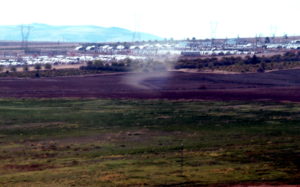
filled with refugees from the war Bashar Assad was conducting against his own people, then north through barren, rocky country until we were almost at the Euphrates.
We didn’t know what we’d see at Göbekli Tepe except that it was going to be archaeology . . . which didn’t narrow it down much. In Turkey, you can’t dig a spoon in the ground without ladling up archaeology.
Göbekli Tepe means Potbelly Hill, and the archaeologists who conducted the 1963 survey of the region hadn’t known what was there, either. They listed the place as a possible Byzantine cemetery on account of the exposed stone slabs which they mistook for grave markers.
Except for the mulberry tree on top,
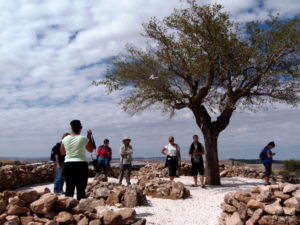
which had been a pilgrimage site for generations, Potbelly Hill was just one more bit of marginal farmland. From time to time, Mahmut and İbrahim Yıldız, the father and son who owned the land, would plow up interesting bits of stone which they’d report to the local museum. But all the serious archaeology took place in the valleys below.
Then stopped taking place, at least for Klaus Schmidt, when the site he was working on was flooded by the Ataturk dam. Casting around for a new place to dig, he realized that the so-called grave markers looked a lot like the tops of prehistoric megaliths he’d excavated at his old site.
Schmidt started work on Potbelly Hill in 1999 and, almost immediately, unearthed huge, T-shaped pillars. The remarkable thing about the pillars was how crisp and fresh they looked,
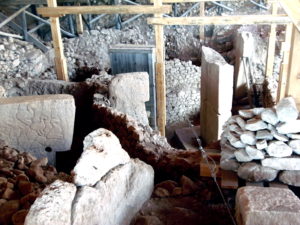
as if they’d been fashioned just last week, instead of 11,000 years ago.
There weren’t any formal guides the day Peg and I showed up, but Mahmut Yildiz was there to show us around.
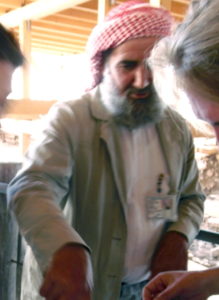
The stone pillars would have been astonishing if they’d been nothing more than fifty-ton slabs of squared-off limestone. But they were much more than that. They were covered with carvings of animals.

Back when they were being made, the Ice Age had just ended and Eastern Turkey was warmer and wetter than it is now. The area around Potbelly Hill was open grasslands filled with wild wheat and wild barley that supported herds of sheep, goats, gazelles and horses.
If the carvings had been almost any place else . . . in a cave in France, say. Or a rock shelter in Lesotho . . . scenes of the hunt, and pictures of the animals hunted . . . would have been carved into the pillars.
There were some game animals at Potbelly Hill. Bulls and boars,
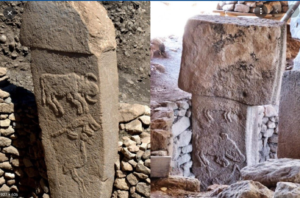
donkeys, maybe,
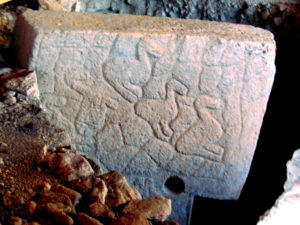
but no hunters. And most of the creatures aren’t the kind of animals you’d hunt. Not for food, anyway. Snakes, lions, spiders, scorpions,
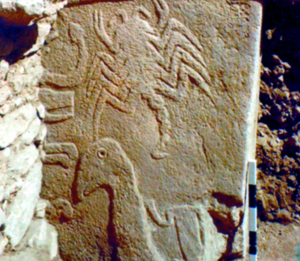
vultures.
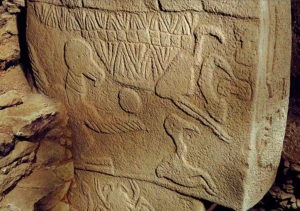
As with the painted caves of Europe, there’s no evidence that anybody lived at Potbelly Hill, so whatever purpose the place served it was probably ceremonial. The difference is that the cave paintings must have had something to do with the hunt. What the carved scorpions and snakes and vultures and predators meant to the people at Potbelly Hill is anybody’s guess.
And, whoever those people were, there must have been a lot of them because they didn’t just carve a couple of big monoliths. The day we visited, only about two percent of Potbelly Hill had been excavated, but geophysical surveys showed something like two hundred pillars still underground, arranged
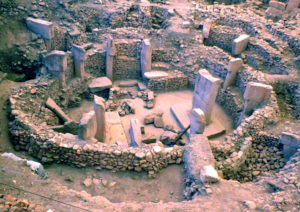
inside circular stone walls up to a hundred feet in diameter fitted out with platforms and what look like shelves for sitting.
The thing is, Potbelly Hill wasn’t Ancient Egypt with lavish surpluses of food to provision an army of artisans. Schmidt found traces of grain left on grinding stones, but it was from wild grasses because farming hadn’t been invented. And the bones he removed were those of wild animals because domestic animals hadn’t been invented, either. Which means that while gangs of workers were piling rocks into circles, or hacking away at limestone with pieces of flint, others were out gathering grain. And still others were hunting animals.
Whoever did all that, they weren’t just passing bands of hunter gatherers migrating with the herds. It took a lot of people and a lot of organization and a lot of time and, to a modern mind, the whole thing smacks of those highly regulated, top-down mega-projects that catch the fancy of absolute monarchs. Which would make sense if kingdoms and city-states and overseers with whips hadn’t been 6,000 years in the future.
How hunter-gatherers could have been persuaded to labor year in and year out without police, or soldiers, or palace functionaries to do the persuading is hard to imagine. Speaking strictly for myself, I would have just gone and hunter-gathered some other place.
Hard as all that is to envisage, the time came when those ancient people did something even stranger. They buried the stone walls and seats, the platforms and shelves and beautifully carved pillars under a huge pile of dirt. Which means that among the surprises Schmidt uncovered was the fact that Potbelly Hill had never been a hill at all. It’s a tell, a mound concealing an archaeological site. And, given the amount of dirt and rubbish it took to conceal it, that, too, must have required considerable organization.
What all that meant to the people who built it, used it for a while, covered it up and then forgot about it, will probably never be known. But what it means to us might be more than anybody had previously guessed. Because that long-ago project could have kicked the entire modern world into motion.
DNA analysis shows that the ancestor of all modern domesticated wheat grows no more than twenty miles from Potbelly Hill. It’s easy to picture teams of people collecting wild grains from the surrounding grasslands, then returning the following year to find stands of wheat sprung from seeds dropped at the collection points. And weave a story of how agriculture sprouted from such beginnings.


No Comments